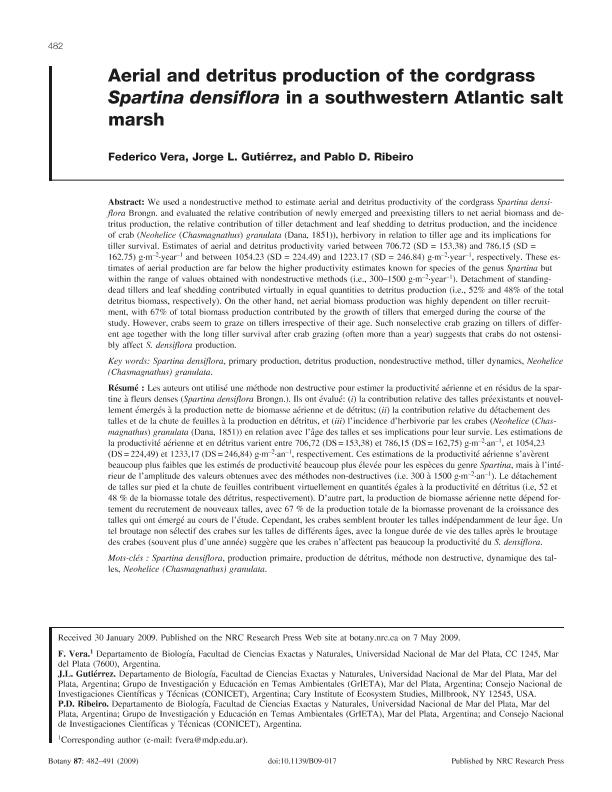Artículo
We used a nondestructive method to estimate aerial and detritus productivity of the cordgrass Spartina densiflora Brongn. and evaluated the relative contribution of newly emerged and preexisting tillers to net aerial biomass and detritus production, the relative contribution of tiller detachment and leaf shedding to detritus production, and the incidence of crab (Neohelice (Chasmagnathus) granulata (Dana, 1851)), herbivory in relation to tiller age and its implications for tiller survival. Estimates of aerial and detritus productivity varied between 706.72 (SD = 153.38) and 786.15 (SD = 162.75) g·m–2·year–1 and between 1054.23 (SD = 224.49) and 1223.17 (SD = 246.84) g·m–2·year–1, respectively. These estimates of aerial production are far below the higher productivity estimates known for species of the genus Spartina but within the range of values obtained with nondestructive methods (i.e., 300–1500 g·m–2·year–1). Detachment of standing-dead tillers and leaf shedding contributed virtually in equal quantities to detritus production (i.e., 52% and 48% of the total detritus biomass, respectively). On the other hand, net aerial biomass production was highly dependent on tiller recruitment, with 67% of total biomass production contributed by the growth of tillers that emerged during the course of the study. However, crabs seem to graze on tillers irrespective of their age. Such nonselective crab grazing on tillers of different age together with the long tiller survival after crab grazing (often more than a year) suggests that crabs do not ostensibly affect S. densiflora production. Les auteurs ont utilisé une méthode non destructive pour estimer la productivité aérienne et en résidus de la spartine à fleurs denses (Spartina densiflora Brongn.). Ils ont évalué: (i) la contribution relative des talles préexistants et nouvellement émergés à la production nette de biomasse aérienne et de détritus; (ii) la contribution relative du détachement des talles et de la chute de feuilles à la production en détritus, et (iii) l'incidence d'herbivorie par les crabes (Neohelice (Chasmagnathus) granulata (Dana, 1851)) en relation avec l'âge des talles et ses implications pour leur survie. Les estimations de la productivité aérienne et en détritus varient entre 706,72 (DS = 153,38) et 786,15 (DS = 162,75) g·m–2·an–1, et 1054,23 (DS = 224,49) et 1233,17 (DS = 246,84) g·m–2·an–1, respectivement. Ces estimations de la productivité aérienne s'avèrent beaucoup plus faibles que les estimés de productivité beaucoup plus élevée pour les espèces du genre Spartina, mais à l'intérieur de l'amplitude des valeurs obtenues avec des méthodes non-destructives (i.e. 300 à 1500 g·m–2·an–1). Le détachement de talles sur pied et la chute de feuilles contribuent virtuellement en quantités égales à la productivité en détritus (i.e, 52 et 48 % de la biomasse totale des détritus, respectivement). D'autre part, la production de biomasse aérienne nette dépend fortement du recrutement de nouveaux talles, avec 67 % de la production totale de la biomasse provenant de la croissance des talles qui ont émergé au cours de l'étude. Cependant, les crabes semblent brouter les talles indépendamment de leur âge. Un tel broutage non sélectif des crabes sur les talles de différents âges, avec la longue durée de vie des talles après le broutage des crabes (souvent plus d'une année) suggère que les crabes n'affectent pas beaucoup la productivité du S. densiflora.
Aerial and detritus production of the cordgrass Spartina densiflora in a southwestern Atlantic salt marsh
Fecha de publicación:
05/2009
Editorial:
Canadian Science Publishing
Revista:
Canadian Journal Of Botany
ISSN:
0008-4026
Idioma:
Inglés
Tipo de recurso:
Artículo publicado
Clasificación temática:
Resumen
Archivos asociados
Licencia
Identificadores
Colecciones
Articulos(CCT - MAR DEL PLATA)
Articulos de CTRO.CIENTIFICO TECNOL.CONICET - MAR DEL PLATA
Articulos de CTRO.CIENTIFICO TECNOL.CONICET - MAR DEL PLATA
Articulos(IIMYC)
Articulos de INSTITUTO DE INVESTIGACIONES MARINAS Y COSTERAS
Articulos de INSTITUTO DE INVESTIGACIONES MARINAS Y COSTERAS
Citación
Vera, Federico; Gutierrez, Jorge Luis Ceferino; Ribeiro, Pablo Damián; Aerial and detritus production of the cordgrass Spartina densiflora in a southwestern Atlantic salt marsh; Canadian Science Publishing; Canadian Journal Of Botany; 87; 5; 5-2009; 482-491
Compartir




